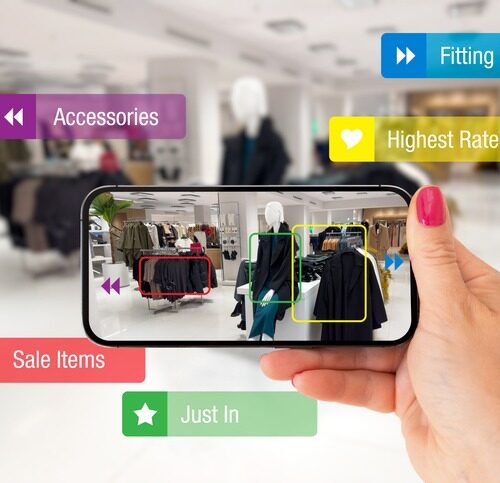Navigating the future of retail requires a clear-eyed view of where we’ve been and where technology is taking us. Integrating advanced technology and changing consumer expectations are profoundly reshaping the shopping experience. This transformation isn’t just about flashy gadgets or novelty; it’s driven by data, efficiency, and a deeper understanding of consumer behavior.
First, consider the impact of e-commerce on consumer habits. Over the past decade, online shopping has surged, accounting for a significant portion of retail sales. In the United States alone, e-commerce sales surpassed $1.1 trillion in 2023, an increase of 7.6 percent from 2022, according to data from the U.S. Census Bureau. This shift to online shopping has forced brick-and-mortar stores to rethink their approach, leading to innovative uses of technology in physical retail spaces to enhance the customer experience and maintain competitiveness.
The COVID-19 pandemic accelerated certain trends, pushing consumers toward more digital and contactless shopping experiences. For instance, the use of mobile payments and apps for shopping increased significantly during the pandemic, with 30% of U.S. consumers using a mobile wallet for the first time in 2020, as reported by Deloitte.
Another critical shift is the demand for a seamless omnichannel shopping experience, where online and offline touchpoints are integrated. Consumers expect to move fluidly between digital and physical channels. A report by the National Retail Federation (NRF) highlighted that nearly 75% of shoppers used multiple channels to shop, emphasizing the importance of a cohesive retail experience across platforms.
Regarding in-store innovations, technologies like augmented reality (A.R.) and smart shelves are making waves. A.R., in particular, is transforming how consumers interact with products, offering virtual try-ons and immersive product information. Meanwhile, smart shelves equipped with weight sensors and RFID technology manage inventory in real-time and personalize the shopping experience by providing tailored recommendations to shoppers.
The role of physical stores is evolving from purely transactional spaces to experiential destinations. Retailers are redesigning store layouts to offer unique in-store experiences, blending shopping with entertainment to attract foot traffic. For example, flagship stores in major cities are incorporating cafes, event spaces, and interactive product demos to create a destination that offers more than just purchases.
Tech-Powered Shopping: From Virtual Reality to Smart Carts
Cutting-edge technologies like virtual reality (V.R.), augmented reality (A.R.), and smart shopping carts are not just a nod to the future—it’s a response to the present demand for enhanced customer experience and convenience.
Virtual fitting rooms and A.R. applications represent the forefront of this transformation. They address a familiar online shopping challenge: the inability to try before you buy. According to a survey by Statista, 35% of consumers stated that the inability to touch, feel, or try products discourages them from online shopping. Virtual fitting rooms bridge this gap, allowing consumers to visualize how clothes will look on them through digital avatars, significantly reducing the uncertainty associated with online purchases. Brands like ASOS and Zara have already integrated these technologies, offering customers a more confident shopping experience, reducing return rates, and enhancing customer satisfaction.
Augmented reality takes the shopping experience further by enabling customers to visualize products in their own space before making a purchase. IKEA’s A.R. app, for example, allows users to see how furniture would fit and look in their homes, making the buying process more interactive and personalized. This technology enhances customer engagement and serves as a powerful decision-making tool, with AR users 40% more likely to make a purchase, according to IBM’s report on the impact of A.R. in retail.
Smart shopping carts are another innovation revolutionizing the in-store experience. These carts, equipped with touch screens and scanners, allow customers to scan items as they shop, providing real-time information on promotions, navigating store layouts, and even processing payments, effectively skipping traditional checkout lines. Walmart’s test of smart shopping carts is a testament to its potential to streamline the shopping process, making it more efficient and user-friendly.
The proliferation of these technologies in retail is not just about novelty; it’s a strategic response to evolving consumer expectations for more immersive, convenient, and personalized shopping experiences. According to a report by the Boston Consulting Group, personalization strategies can boost revenues by 6 to 10%, indicating the significant impact of technology on retail success.
Integrating V.R., AR, and smart technologies into retail environments transforms shopping from a mere transaction to an engaging, immersive experience. As retailers continue to innovate, the line between digital and physical shopping experiences blurs, creating a new paradigm where technology enhances every step of the consumer journey.
Navigating the Aisles: How Shopper Insights Shape Store Layouts
The design and layout of retail spaces are no longer solely about aesthetics or maximizing the number of products on display. Today, it’s a sophisticated blend of art and science, leveraging extensive data on shopper behavior to create environments that sell more effectively and enhance the overall shopping experience. This strategic approach to store design uses insights gained from customer interactions, both in-store and online, to inform every aspect of the retail environment, from product placement to the navigational flow.
Understanding how and why customers move through stores is crucial. Retailers increasingly use technology to gather these insights, using tools like heat maps generated from security camera footage and Wi-Fi tracking to analyze foot traffic patterns. These technologies reveal high-traffic areas, shopper dwell times, and how effectively different store layouts and displays attract attention. For example, a study published in the Journal of Retailing demonstrated that subtle changes in store layout can significantly influence shopping behavior and sales, underscoring the importance of layout optimization.
The science of store design also extends to product placement strategies. Data analytics help retailers understand which products are frequently purchased together and how their placement within the store can drive sales. The strategic placement of high-demand or impulse-buy items near the front of the store or checkout lines capitalizes on shopper psychology, potentially increasing basket size and influencing purchase decisions.
Integrating digital elements into physical stores redefines the concept of layout optimization. Interactive displays and digital signage offer personalized recommendations and product information, enhancing the shopper’s journey by making it more informative and engaging.
This blend of physical and digital elements caters to the expectations of today’s tech-savvy consumers, who seek a seamless shopping experience that combines the convenience of online shopping with the tactile benefits of in-store browsing.
Customizing store layouts based on local demographics and shopper preferences is another area where data plays a pivotal role. Retail giants like Target and Walmart have embraced this strategy, tailoring store layouts and product selections to the needs and preferences of local communities, thereby fostering a more personalized shopping experience.
The modern approach to store design is data-driven, focusing on creating spaces that sell by aligning with shopper preferences and behaviors. This method enhances the customer experience and drives sales, proving that in the competitive retail industry, understanding and catering to the shopper’s needs is paramount.
More Than a Store: Creating Immersive Shopping Experiences
Stores are no longer mere points of transaction but arenas of engagement and entertainment. Retailers are reinventing their spaces to offer immersive shopping experiences that go beyond traditional shopping, making every visit memorable and engaging. This evolution reflects a broader trend where shopping is not just about acquiring goods but about enjoying an experience that combines leisure, learning, and purchasing.
Image credit: Apple
One of the most compelling ways retailers enhance the in-store experience is through live demonstrations and workshops. These events transform the shopping journey into an interactive and educational experience, fostering a deeper connection between the brand and its customers. For example, Apple’s Today at Apple sessions, which offer workshops on photography, music, and art using Apple products, educate customers and create a community around the brand’s ecosystem. These sessions leverage the store’s space to engage customers in a way that online shopping cannot replicate, adding value to the physical shopping experience.
Interactive displays and engaging technology also play a pivotal role in modern retail strategies. Stores are incorporating touchscreens, virtual reality stations, and augmented reality apps to create a hands-on shopping environment. Sephora’s Virtual Artist, for instance, allows customers to try on makeup virtually using A.R., combining the convenience of digital browsing with the tactile experience of in-store shopping. These technologies entertain and inform the purchasing decision, making shopping more efficient and enjoyable.
Image credit: Sephora
Retailers are also turning their stores into destinations by incorporating elements typically associated with leisure and entertainment. Bookstores with cafes, clothing stores with lounge areas, and electronics shops with gaming zones encourage customers to spend more time in-store, increasing the likelihood of purchases. These spaces offer customers a break from the conventional shopping routine, creating a more relaxed and engaging environment.
Moreover, the concept of experiential retail extends to the layout and theming of stores. Flagship stores, in particular, are designed to embody the brand’s identity and values, offering unique experiences that cannot be found elsewhere. For example, the Nike House of Innovation provides a highly personalized shopping experience, including a floor dedicated to local artists and designers, showcasing the brand’s connection to the local community and culture.
Photo: Nike House of Innovation Shanghai
In transforming their spaces into stages for entertainment and engagement, retailers are not just selling products; they are selling experiences. This shift towards experiential retail reflects a deeper understanding of consumer desires for connection, entertainment, and personalization. By creating immersive shopping environments, retailers can differentiate themselves in a crowded market, build lasting relationships with consumers, and drive sales and loyalty.
Blurring the Lines: The Seamless Integration of Online and In-Store
In this new retail reality, omnichannel strategies stand out as essential for connecting with the digital shopper, ensuring a seamless and integrated shopping journey across all channels. This approach is not just about having a presence across multiple platforms; it’s about creating a cohesive, personalized experience that resonates with consumers wherever they are.
The essence of a successful omnichannel strategy lies in its ability to offer an integrated shopping experience that is consistent yet tailored across all touchpoints. Retail apps are crucial in this integration, bridging the digital and physical worlds. These apps can store preferences, past purchases, and browsing history to offer personalized recommendations and promotions, enhancing the online and in-store shopping experience. For example, the Starbucks app allows customers to order and pay ahead and rewards them for purchases across different channels, fostering loyalty and convenience.
Photo credit: Starbucks
Social media has also become a key component of omnichannel retailing, offering unique ways to engage consumers. Brands leverage platforms like Instagram and Pinterest for marketing and direct sales through shoppable posts and ads. This strategy taps into the shopper’s desire for discovery and convenience, allowing them to transition smoothly from inspiration to purchase without leaving their preferred social platform.
In-store technology further exemplifies the merging of online and physical shopping experiences. Digital kiosks and interactive screens allow customers to access online reviews, check inventory, or order products not available in-store directly from the shop floor. Retailers like Macy’s and Kohl’s have implemented these technologies to extend their product offerings and provide customers with more options, catering to the shopper’s expectation for comprehensive, immediate access to information and purchase options.
The collection and analysis of data from these various channels enable retailers to gain deeper insights into consumer behavior, preferences, and trends. This data-driven approach allows for more accurate forecasting, inventory management, and personalized marketing efforts, ultimately enhancing the customer experience and optimizing operations.
The success of an omnichannel strategy hinges on its ability to create a shopping experience that is not just cohesive across channels but also adaptable to the evolving preferences and behaviors of the modern consumer. By effectively integrating online and in-store experiences, retailers can meet the heightened expectations of today’s digital shoppers, offering them the convenience, personalization, and seamless journey they demand.
The future of retail lies in blurring the lines between the digital and physical shopping realms. Through omnichannel strategies that leverage apps, social media, and in-store technology, retailers can create unified and personalized experiences that resonate with consumers, driving engagement, loyalty, and sales.
Tomorrow’s Retail Today: Innovations Shaping the Future of Shopping
It’s clear that the sector is on the cusp of a new era of innovation driven by technological advancements and a deepening commitment to sustainability. The coming years promise to usher in a range of transformative trends, from AI-driven personal shopping assistants to the use of blockchain for enhancing authenticity and supply chain transparency. These innovations are not merely speculative but the building blocks of tomorrow’s retail landscape, poised to reshape how we shop, sell, and engage with brands.
Artificial Intelligence (A.I.) is set to play a starring role in the future of retail, offering personalized shopping experiences that were once the realm of science fiction. Imagine walking into a store where an A.I. personal shopping assistant greets you by name, knows your preferences and past purchases, and can predict what you might need or want with uncanny accuracy. This level of personalization, powered by A.I. and machine learning algorithms, has the potential to dramatically enhance the shopping experience, making it more efficient, enjoyable, and tailored to individual preferences.
Blockchain technology is another frontier in the evolution of retail, promising to bring unprecedented levels of transparency and authenticity to the shopping experience. In an age where consumers are increasingly concerned about the provenance and integrity of the products they buy, blockchain offers a solution. By securely recording every step of a product’s journey from manufacture to sale, blockchain can provide consumers with a transparent record of authenticity, origin, and supply chain practices. This builds trust and empowers consumers to make informed decisions based on ethical and environmental considerations.
Photo credit: LUSH
Sustainability is also set to redefine retail, influencing not just product design but the very architecture of retail spaces. As environmental concerns become increasingly central to consumer values, retailers are responding with initiatives that minimize environmental impact and promote sustainable practices. Sustainability is becoming a cornerstone of retail strategy from zero-waste packaging and biodegradable materials to energy-efficient store designs and promoting circular economies. These efforts reflect a commitment to the planet and an understanding that the future of retail lies in aligning with the values and expectations of the modern consumer.
Integrating these innovations into the retail sector signifies a broader shift towards a more personalized, transparent, and sustainable shopping experience. As technology continues to evolve and consumer preferences shift towards more ethical and environmentally friendly practices, the retail landscape will adapt, embracing new tools and strategies to meet the demands of tomorrow’s shopper.
Crafting the Ultimate Shopping Experience
The ultimate shopping experience of the future hinges on more than just transactions; it’s about crafting moments that resonate, connect, and engage at every touchpoint. This evolution isn’t merely a response to changing market dynamics but a proactive embrace of the possibilities that lie at the intersection of innovation, consumer behavior, and retail environments.
The digital age has ushered in a new breed of consumers, ones who are informed, connected, and value-conscious. Their expectations are not static; they evolve as rapidly as the technology they wield daily. This dynamic landscape presents a unique challenge for retailers: to stay ahead, not just in pace but in anticipation of the shifts in consumer behavior. The key to unlocking this lies in understanding that the consumer is at the heart of every technological advancement, every redesigned store layout, and every piece of in-store entertainment.
Today’s consumers are seeking more than a product; they are pursuing an experience that aligns with their values, needs, and lifestyle. They value authenticity, transparency, and personalization. They are drawn to brands that not only understand their preferences but also anticipate their needs and engage them in meaningful ways. This shift towards experiential retailing requires a deep dive into the psychology of shopping, leveraging data analytics and consumer insights to create environments that delight, engage, and inspire.
The future of retail, therefore, is not just about adopting new technologies or redesigning physical spaces; it’s about creating a holistic ecosystem that caters to the multifaceted desires of the modern shopper. It’s about integrating digital fluency with physical presence, crafting narratives that engage consumers emotionally and intellectually, and fostering communities around brands and experiences.
Retailers who navigate this shift successfully will view change not as a challenge but as an opportunity to reimagine the shopping experience, connect with consumers on a deeper level, and build lasting relationships that transcend the transactional. The ultimate shopping experience of the future will be defined by the ability of retailers to adapt, innovate, and resonate with the ever-evolving consumer.
The retail landscape is at a crossroads, with technology, consumer behavior, and retail environments converging to redefine what shopping means. As we look to the future, the brands that will thrive are those that recognize and respond to this shift, embracing the possibilities that come with understanding and anticipating the needs and desires of today’s consumers. The ultimate shopping experience lies in this understanding and in the seamless integration of technology, design, and engagement that speaks directly to the heart of the consumer.
Get regular insights
Keep up to date with the latest insights from our research as well as all our company news in our free monthly newsletter.





 Senior Marketing Executive
Senior Marketing Executive Sales & Marketing
Sales & Marketing General Manager PR -Internal Communications & Government Affairs
General Manager PR -Internal Communications & Government Affairs Vital Strategies
Vital Strategies
 Customer Intelligence Director
Customer Intelligence Director